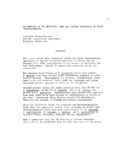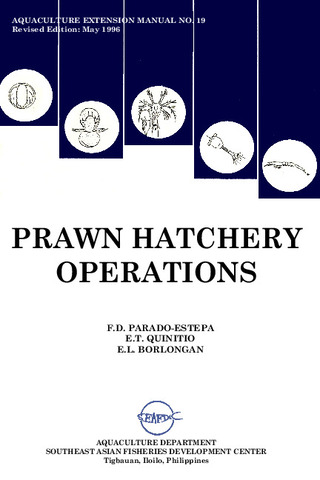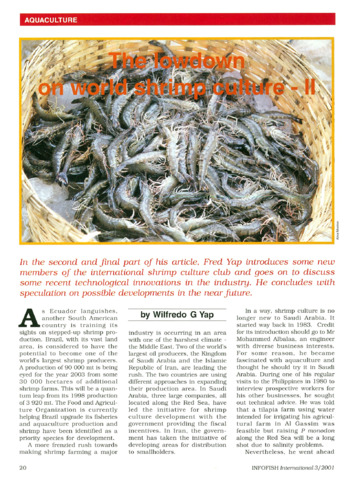Survival rates of different postlarval stages of Penaeus monodon Fabricius
- Global styles
- MLA
- Vancouver
- Elsevier - Harvard
- APA
- Help

Date
1977Author
Page views
3,093ASFA keyword
AGROVOC keyword
Taxonomic term
Metadata
Show full item record
Share
Abstract
The objective of this study is to determine survival rates of different postlarval stages upon stocking in the Leganes ponds. Twelve 3m x 2m x 2m suspension nets made of nylon cloth (mesh size = 0.1 mm) were set up in a Leganes Station pond (ave. water depth = 1 m) by means of 3-m long poles stacked at distances approximating the area of each net. The net bottom was filled with topsoil at least 15 cm thick to stimulate the pond bottom. At least 60 cm of the upper edge of each net was above the water level to prevent mixing of water inside and outside the net. P. monodon of stages P11, P15, P21 (from the hatchery) and P25 (from the wet lab) were stocked in the nets at 200/sq m or 1,200 fry/net. Due to lack of fry, only one P25 net was stocked. Each net had two large dried miapi branches as shelter from predation and cannibalism for the young sugpo fry. Fresh lablab was fed at the rate of one pail (approximately 5 kg) every four days per net. Harvest data show relatively higher survival rates for P15 and P18 compared to P11 and P25 with no significant difference between these two stages. The results for P25 may not be valid because the stock came from the wet lab in comparison to the other postlarval stages which were reared in the hatchery. Moreover, the P25 stock had no replicates and the net itself (no. 10) was discovered to have many holes. These preliminary results point to P15 as the best stage for harvest from the hatchery in terms of high pond recovery and lesser expense in rearing compared to older postlarvae.
Description
Extended abstract only.
Suggested Citation
Primavera, J. (1977). Survival rates of different postlarval stages of Penaeus monodon Fabricius. SEAFDEC Aquaculture Department Quarterly Research Report , 1(2), 30-33. http://hdl.handle.net/10862/2291
Type
ArticleCollections
Related items
Showing items related by title, author, creator and subject.
-
An overview of the nutrition, feed and feeding techniques of prawn penaeid/shrimps
Piedad-Pascual, Felicitas (Philippine Council for Aquatic and Marine Research and Development, 1989)This paper echoes what transpired during the first International Conference of Penaeid Prawns/Shrimps held in Iloilo City in December 4-7, 1984, particularly on the Nutrition nd Feed Development. Around 25 papers were ... -
Series: Aquaculture extension manual; No. 19
Prawn hatchery operations
Parado-Estepa, Fe D.; Quinitio, Emilia T. ; Borlongan, Emeterio L. (Aquaculture Department, Southeast Asian Fisheries Development Center, 1996-05)
The manual, an updated version of the 1984 SEAFDEC/AQD manual, presents the underlying principles and step-by-step instructions of prawn larval and post-larval rearing. The techniques described are not only applicable to ...
; Borlongan, Emeterio L. (Aquaculture Department, Southeast Asian Fisheries Development Center, 1996-05)
The manual, an updated version of the 1984 SEAFDEC/AQD manual, presents the underlying principles and step-by-step instructions of prawn larval and post-larval rearing. The techniques described are not only applicable to ... -
The lowdown on world shrimp culture - II
Yap, Wilfredo G. (INFOFISH, 2001)This paper introduces some new members of the international shrimp culture club and goes on to discuss some recent technological innovations in the industry, particularly the polyculture of tilapia (mainly Oreochromis ...






